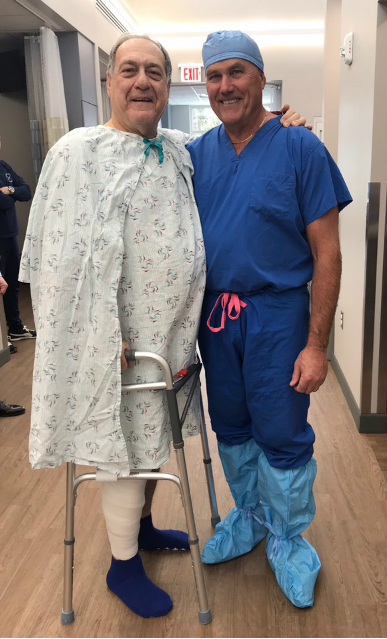Knee Surgery without a Hospital Stay

Dr. Gordon Zimmermann stands with our first MAKOPLASTY patient at our new Orthopedic Associates Surgery Center in Rocky Hill. MAKO is a partial knee replacement that can almost always be done on an outpatient basis without the need for hospitalization. This results in a much shorter recovery time with less pain and greatly increased patient satisfaction.
See below to learn about MAKO and if it is right for you.
Do I Really Need A Full Knee Replacement or Will a Partial Do?
By Gordon A. Zimmermann, MD
Total joint replacements are becoming more and more frequent with our aging population. Presently over one million hip and knee replacements are done annually in the US. Of this total, 700,000 are knee replacements with a projection of 3.5 million knee replacements by 2030. Despite very good final outcomes knee replacement has a deserved reputation as being a painful procedure with many months of recovery. Improved anesthetic blocks with longer acting medications and improved perioperative pain management have made a significant difference but unfortunately not enough. Patients frequently ask us about whether there is a better surgical alternative and for as many as 50% of patients a partial knee replacement offers many major advantages. With state of the art advanced robotic assistance partial knee replacements are much more precise regards sizing, fit and balancing. Neither partial knee replacement nor robotics are anything new. We have done partial knee replacements manually for years but the results and the longevity were not as good as total knee replacements until recently. Today even with manual techniques the retention of implants have been 98%, 95% and 93% at ten, fifteen and twenty years. The first ten year report on the robotic MAKO platform shows over 98 percent retention. MAKO is the number one robotic platform in the industry. The major advantages to you as patients are as follows:
- The procedure can almost always be done as an outpatient without need for hospitalization.
- The recovery is measured in weeks not months.
- The pain is much less.
- The final range of motion is better.
- The incision is smaller.
- Patient satisfaction is much higher.
So why have a painful in-hospital procedure with months of recovery if it is not necessary? Call and schedule an appointment with one of our MAKO trained surgeons and see if you are candidate. You can learn more about robotic partial knee replacement at patients.stryker.com.
